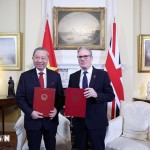Total number of posts 426.
ACFTA 3.0, expected to be signed by the end of 2025, represents a significant upgrade to the ASEAN–China Free Trade Agreement, with a focus on the digital economy, green growth, and supply chain connectivity. The upgraded agreement is expected to promote deeper regional integration and enhance the region’s economic resilience, especially as ASEAN–China trade relations reach their highest level to date.
Expected to be signed by the end of 2025, the upgraded Protocol of the ASEAN-China Free Trade Agreement (ACFTA) 3.0 is anticipated to serve as a pivotal milestone in shaping the next phase of economic cooperation between ASEAN countries and China. By focusing on key areas such as the digital economy, green economy, and supply chain connectivity, ACFTA 3.0 will lay the foundation for a strategy of deeper, innovative, and sustainable regional integration.
According to ASEAN Secretary-General Kao Kim Hourn, the upgraded version will “open new doors” for future economic cooperation through modern provisions on competition, consumer protection, and digital capabilities. Similarly, Priyanka Kishore, Principal Economist at Asia Decoded, highlighted that ACFTA 3.0 would strengthen supply chain resilience and boost economic integration in a rapidly evolving global landscape.
However, some experts have cautioned ASEAN to be wary of potential risks associated with China’s industrial overcapacity, as well as the possibility that large Chinese firms could outcompete local businesses, especially in sectors like electric vehicles (EVs), digital infrastructure, and green technology. While countries such as Vietnam and Thailand are likely to benefit early from increased investment, others in the region may face challenges related to insufficient technology transfer during the investment process.
On the other hand, Singapore and Malaysia are expected to continue serving as key hubs in the regional digital economy, thanks to their technological capacity and competitive edge in digital service exports, particularly in cross-border fintech cooperation with China.
The release of ACFTA 3.0 comes as ASEAN-China trade reaches historic highs. According to China’s General Administration of Customs, two-way trade between ASEAN and China reached 3.02 trillion yuan (approximately USD 420.5 billion) in the first five months of 2025, marking a 9.1% year-on-year increase. ASEAN has thus surpassed both the EU and the US to become China’s top trading partner. During the same period, China’s exports stood at 10.67 trillion yuan (up 7.2%), while imports fell to 7.27 trillion yuan (down 3.8%).
These impressive figures reflect the vast potential and growing need to modernize the legal and institutional framework supporting economic ties. As such, ACFTA 3.0 is not only a strategic economic initiative but also a testament to the shared political will of ASEAN and China to strengthen regional connectivity and embrace inclusive, green, and digital growth in an era of global transformation.
Source: BusinessToday














